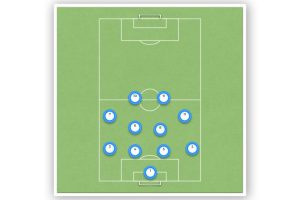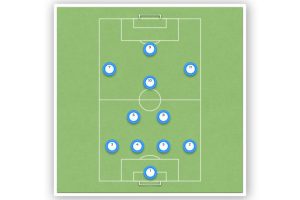Mastering the Double Pivot in 4-2-3-1 Formation
A double pivot is a common formation in soccer that involves two holding midfielders positioned in front of the defensive line. It is most commonly seen in the 4-2-3-1 formation, which features four defenders, two central midfielders, three attacking midfielders, and a lone striker. The double pivot is used to provide extra defensive cover while also allowing for quick transitions to attack.
The two central midfielders in the double pivot work together to provide a solid foundation for the team. They are responsible for breaking up opposition attacks and initiating their team’s own attacks. The double pivot is particularly effective in controlling the center of the field, which is crucial in modern soccer.
Teams that use the double pivot effectively can dominate possession and control the tempo of the game. It is a versatile formation that can be adapted to suit different playing styles and opposition tactics. However, it requires a high level of tactical awareness and discipline from the central midfielders to be successful.
What is a Double Pivot?
A double pivot is a tactical formation used in soccer where two holding midfielders operate in front of the defensive line and behind the attacking midfielders. This formation is most commonly seen in a 4-2-3-1 formation, where the two holding midfielders sit in front of the back four and behind the attacking midfielders.
The double pivot is a crucial part of the 4-2-3-1 formation as it provides defensive cover while also allowing for quick transitions from defense to attack. The two holding midfielders work together to shield the defense, break up opposition attacks, and distribute the ball to the attacking players.
One of the advantages of the double pivot is that it allows the attacking midfielders to focus on creating chances and scoring goals without having to worry too much about defensive responsibilities. The two holding midfielders can cover the gaps left by the attacking players and provide a solid foundation for the team to build from.
| Advantages | Disadvantages |
|---|---|
| Provides defensive cover | May leave gaps in the midfield |
| Allows for quick transitions from defense to attack | Requires two specialized players |
| Allows attacking midfielders to focus on creating chances | May limit attacking options |
The 4-2-3-1 Formation

The 4-2-3-1 formation is a popular tactical formation in soccer. It is a balanced formation that offers both defensive stability and attacking options. The formation consists of four defenders, two central midfielders, three attacking midfielders, and one striker. The two central midfielders in the 4-2-3-1 formation are commonly referred to as the double pivot. They are positioned in front of the central defenders and behind the attacking midfielders. The double pivot is responsible for providing defensive cover for the backline and distributing the ball to the attacking players. The 4-2-3-1 formation is flexible and allows for variations in attacking play. The attacking midfielders have the freedom to move around the pitch and create chances for the striker. The wingers can stretch the opposition’s defense and create space for the attacking midfielders to exploit. The double pivot in the 4-2-3-1 formation is critical to the team’s success. The midfielders must have excellent defensive and passing abilities to control the midfield and provide support for the attacking players. A strong double pivot can help the team maintain possession and control the tempo of the game. In summary, the 4-2-3-1 formation is a balanced formation that provides both defensive stability and attacking options. The double pivot is a crucial component of the formation and is responsible for controlling the midfield and distributing the ball to the attacking players.
How the Double Pivot Works in 4-2-3-1
Defensive Responsibilities
The double pivot in a 4-2-3-1 formation is a withdrawn central midfield pairing that is positioned in front of the central defenders, inside the full-backs or wing-backs, and behind the attacking midfielders. The primary defensive responsibility of the double pivot is to protect the back four and prevent the opposition from penetrating the defensive line. They must be tactically intelligent, positionally aware, and able to read the game well to anticipate and intercept passes.
When defending, the double pivot must be compact, closing down space between the lines, and pressing the opposition’s midfielders. They must work in tandem, communicating effectively to cover each other’s positions and prevent the opposition from exploiting space between the lines.
Attacking Responsibilities
While the primary role of the double pivot is defensive, they also play a crucial role in the attacking phase of the game. The double pivot is responsible for initiating the team’s attacks, playing forward passes to the attacking players, and creating opportunities for the team to score.
When in possession, the double pivot must be comfortable on the ball, able to pick out passes, and move the ball quickly to transition from defense to attack. They must be able to spot gaps in the opposition’s defense and exploit them by playing through balls or switching the play to the flanks.
Transitioning Between Defense and Attack
The double pivot plays a crucial role in transitioning from defense to attack and vice versa. When the team loses possession, the double pivot must quickly transition into a defensive position, closing down the opposition’s midfielders and preventing them from playing forward passes.
When the team wins possession, the double pivot must quickly transition into an attacking position, moving the ball forward and creating opportunities for the attacking players to score. They must be able to read the game well and anticipate the opposition’s movements to quickly transition between defense and attack.
| Defensive Responsibilities | Attacking Responsibilities | Transitioning Between Defense and Attack |
|---|---|---|
| Protect the back four | Initiate attacks | Quickly transition from defense to attack and vice versa |
| Close down space between the lines | Play forward passes to attacking players | Read the game well and anticipate opposition’s movements |
| Work in tandem to cover each other’s positions | Create opportunities for the team to score |
Advantages of Using a Double Pivot in 4-2-3-1
A double pivot in a 4-2-3-1 formation can provide several advantages to a team. Here are some of the benefits:
| Advantages | Description |
|---|---|
| Defensive Stability | The double pivot provides a solid defensive base for the team. The two defensive midfielders can protect the backline and prevent the opposition from creating chances. |
| Control of the Midfield | The double pivot can dominate the midfield and control the tempo of the game. The two central midfielders can work together to win the ball back and distribute it to the attacking players. |
| Flexibility in Attack | The double pivot can provide flexibility in attack. One of the two central midfielders can push forward to support the attackers, while the other stays back to cover defensively. |
Another advantage of using a double pivot is that it can allow the attacking players to focus on creating chances and scoring goals. With two defensive midfielders behind them, the attacking players can take more risks and be more creative in their play.
Furthermore, a double pivot can be effective against teams that play with a single striker. The two central midfielders can mark the opposition’s attacking midfielder and prevent them from creating chances.
Overall, a double pivot in a 4-2-3-1 formation can provide a team with defensive stability, midfield control, flexibility in attack, and an effective way to counter the opposition’s attacking midfielder. It can be a valuable tactic for teams looking to dominate the midfield and control the game.
Disadvantages of Using a Double Pivot in 4-2-3-1
While the 4-2-3-1 formation is a popular choice for many soccer teams, it is not without its drawbacks. One of the most significant disadvantages of using a double pivot in this formation is that it can hinder the performance of natural creators in the midfield.
If a team’s midfielders are naturally inclined to be creators, playing them in a double pivot can limit their ability to contribute creatively to the team’s attack. This is because the double pivot can crowd central spaces for a more creative, deep-lying midfielder who might be more effective as a single pivot.
Another disadvantage of using a double pivot in the 4-2-3-1 formation is that it can lead to fewer options for ball progression via the midfield. If both pivot players move into similar positions, they can end up doing the job of one player, leaving the team with fewer options for advancing the ball up the field.
Additionally, if the midfield bands are forced back and compressed into a 4-5-1, the striker can become isolated and starved of service. This can make it difficult for the team to create scoring opportunities and can lead to a lack of goals.
| Disadvantages of Double Pivot in 4-2-3-1 |
|---|
| Hinders natural creators |
| Fewer options for ball progression |
| Can lead to a 4-5-1 formation and isolate the striker |
Conclusion
The double pivot in the 4-2-3-1 formation is a popular tactic used by many football teams around the world. It provides a strong defensive base while also allowing for attacking flexibility. The two central midfielders work together to control the midfield, protect the defense, and initiate attacks. One of the key benefits of the double pivot is its ability to create a balanced midfield. The two players work together to cover each other’s positions and responsibilities, allowing for greater control of the ball and more options in attack. This balance also helps to prevent counterattacks by quickly regaining possession and transitioning to attack. Another advantage of the double pivot is its ability to adapt to different situations. Depending on the opponent and the game situation, the two midfielders can adjust their roles and responsibilities. For example, one midfielder may stay back to protect the defense while the other pushes forward to support the attack. Overall, the double pivot in the 4-2-3-1 formation is a versatile and effective tactic that provides a strong foundation for both defense and attack. Its ability to create balance and adapt to different situations makes it a popular choice for many football teams around the world.





